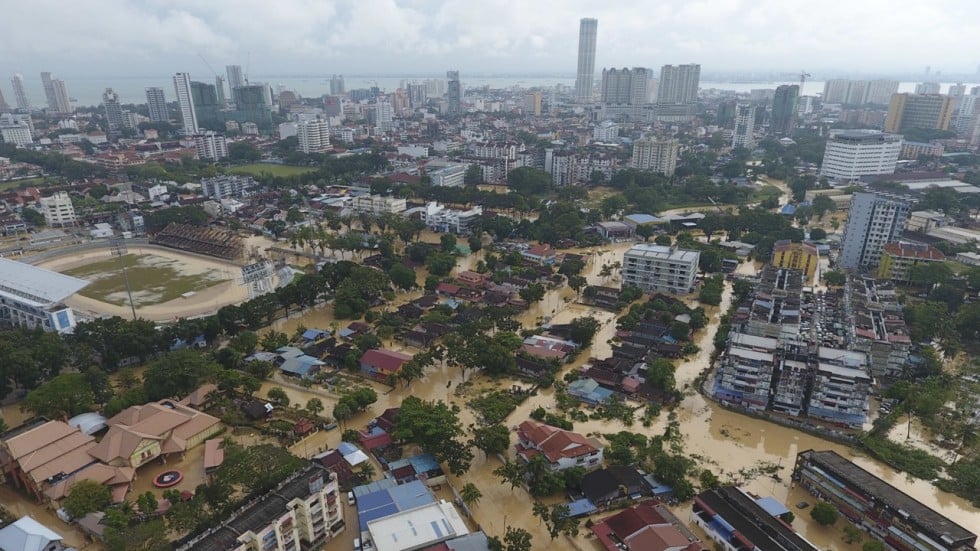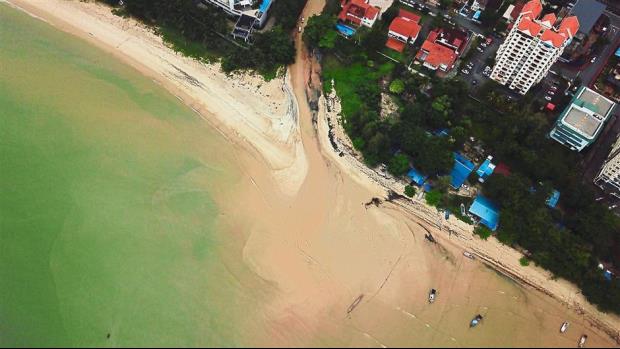https://www.thestar.com.my/news/nation/2019/06/27/pwd-tragedy-caused-by-slope-instability/?jwsource=cl
 |
| Earth patch: Workers covering the landslide area with canvas to prevent more soil erosion in Tanjung Bungah. |
 |
| mayor Yew Tung Seang. |
He said that the slope was unstable due to digging activities as the resort’s owner was building a retaining wall without informing the authorities.
“It’s not a landslide. The incident occurred after the retaining wall collapsed within the resort’s premises.
“We need to be informed of any construction activity and make sure that it is done under the supervision of engineers.
“We are monitoring the situation closely before making a decision on whether to stop the resort’s operations,” he said at a press conference after the launching of the Karpal Singh Digital Hub at SK Sungai Gelugor yesterday.
On Tuesday, four foreign workers were buried alive in a freak accident at the construction site in Tanjung Bungah.
It is learnt that the resort owner recently contracted a Myanmar worker to build a retaining wall after finding that the hill separating the resort and Jalan Batu Ferringhi showed signs of erosion.
The contractor hired three other Myanmar nationals to assist him.
Checks found that the retaining wall, which was supposed to be about 5m wide, had yet to be built but there were other retaining walls beside it.
State local government committee chairman Jagdeep Singh Deo said mitigation works along the 50m stretch of Jalan Batu Ferringhi would be completed in three to four weeks’ time.
“Although the incident happened on private land, it has affected the federal road where many heavy vehicles pass by every day.
“It is important to stabilise the road to ensure the safety of road users,” he said.
Meanwhile, Citizens Awareness Chant Group adviser Yan Lee called on the MBPP to reveal its standard operating procedures for investigating illegal earthworks done in the state.
“I hope that the council can share with us how many officers or workers are available to check on such earthworks,” he said.
Source link
GEORGE TOWN: Soil movement due to slope instability is said to be the cause of the freak landslide that claimed four lives at a beach resort in Batu Ferringhi, says Penang Public Works Department (PWD) director Shahabuddin Mohd Muhayidin.
He said preliminary investigations showed that the slope was unstable as a result of digging by a third party.
“The digging at the slope caused soil movement with a whole lot of earth coming loose.
“Right now, we are taking the necessary steps to stop further soil erosion at the slope.
“After this, we will install sheet piles to stabilise the slope,” he told reporters at a press conference in Komtar yesterday.
Following the landslide, Chief Minister Chow Kon Yeow had ordered PWD to conduct a thorough study of Jalan Batu Ferringhi to check on conditions of the road and slopes along the 15km stretch.
“If the study finds any of the slopes or roads unsafe, repair works will be carried out following recommendations from the study.
“For now, a 50m-stretch of the road leading to Teluk Bahang has been closed for mitigation work and to ensure the safety of road users.
“The mitigation work is expected to be complete within three to four weeks, and in the meantime, a flagman will be assigned at the road stretch to direct the one-way traffic,” said Chow at the press conference.
He said the state had no information on the status of the Myanmar workers who died in the incident.
“Relevant authorities will need to investigate the landowner and project owner so that appropriate action can be taken.
Chow said they have called on the police and government agencies like the Department of Occupational Safety and Health to investigate the and take action against those responsible.
“From monitoring at the site, we believe the works to build the retaining wall were carried out without professional help.
“It was just action taken by the landowner who wanted to fix a condition on the site. And, due to the way the work was carried out, it caused soil movement and eventually the soil collapsed.”
He said PWD and the Penang Island City Council (MBPP) would continue monitoring the issue.
“In this incident, the landowner should be responsible as he or she is responsible for monitoring the land.
“Although the landowner tried to take the initiative to build the wall, professional help should have been sought to ensure safer and more secure work.”
MBPP mayor Datuk Yew Tung Seang said the council would serve notices to the landowner and other parties concerned under Section 70A of the Street, Drainage and Building Act 1974.
“MBPP is investigating, and will take appropriate action against the parties involved.
“Although we have a team monitoring illegal construction, the construction work on this particular site was not visible to public view.”
Yew advised landowners to apply for permits before embarking on any construction work in future.
Source link
Experts: Human error could have led to landslide

GEORGE TOWN: A landslide which occurred even when there was no rain to trigger it might have been due to many reasons, including human error, says an expert.
Universiti Sains Malaysia geotechnical engineering professor Prof Dr Fauziah Ahmad said the workers may have dug at the toe of the slope while trying to build a retaining wall.
“During the digging process, pressure might have been released from the top of the wall, which could already have had cracks.
Prof Fauziah said traffic vibrations could also trigger pressure and cracks on the wall.
“Once there are cracks, water will seep through over a period of time, and when it reaches the instability between backfill and the wall, the slope will collapse,” she added.
Prof Fauziah was asked to comment on the incident on Tuesday where four foreign workers were buried alive in a landslide at a construction site in Batu Ferringhi.
Universiti Teknologi Malaysia Centre of Tropical Geoengineering director Prof Dr Edy Tonnizam Mohamad said the stability of a slope, among others, depends on its soil properties, slope geometry, volume, effect of gravity and also the pore water pressure.
“A slope could fail if one or a combination of factors passed its equilibrium and factor of safety.
“If the geometry of a slope is not properly designed according to geologic, engineering and climatic factors, a slope failure could occur.
“There have been several cases of landslides even when there was no rain,” he said.
Prof Edy added that to prevent such incidents, monitoring and inspection before and during construction is important.
“Professional supervision is also needed at the construction site.
“During construction, the standard operating procedure should be made clear.
“The construction site should be managed properly and safety procedures adhered to,” he said.
‘Owner built walls on his own’
 |
Earth patch: Workers covering the landslide
area with canvas to prevent more soil erosion in Tanjung Bungah. —
MUSTAFA AHMAD & ANDY LO/The Star
|
GEORGE TOWN: The owner of a resort along Jalan Batu Ferringhi may have been building walls on his own to prevent soil erosion for some time before a landslide struck, killing four foreign workers.
Penang Works, Utilities and Flood Mitigation Committee chairman Zairil Khir Johari said there were signs of such efforts but the authorities had never been informed.
“It appears to me like he had been doing it on his own, without informing the authorities,” he said.
Attempts to contact the resort owner for comments were futile as of press time.
On Tuesday, four foreign workers were buried alive in a freak landslide at a construction site in Batu Ferringhi at 9.21pm.
George Town OCPD Asst Comm Che Zaimani Che Awang said all four bodies had been recovered.
He added that three of the victims were discovered in a standing position while holding the metal poles for the retention wall while the other was leaning over.
He said the victims did not have any identification papers.
It is learnt that the resort owner had recently contracted a Myanmar worker called Ong to build a retaining wall after finding that the hill separating the resort and Jalan Batu Ferringhi showed signs of erosion.Ong then hired three other Myanmar nationals, to assist him.Checks found that the retaining wall, which was to be about five metres wide, had yet to be built but there were other retaining walls beside it.
The exposed slope has been covered with tarpaulin sheets to prevent further erosion.
Read more:
Related posts:
Penang landslides & flooding are natural disasters man-made?

Invalid drainage and construction damaged nearby houses since 2014 must complete its mitigation quickly!

Introduction to Slope Stability | Soil Mechanics
https://youtu.be/rlCmaYi2rYk























